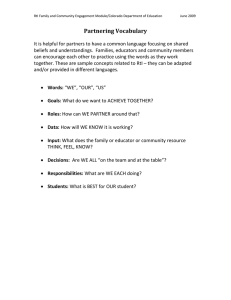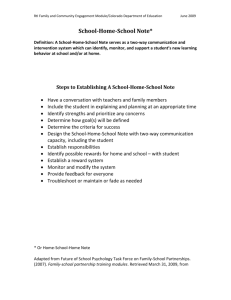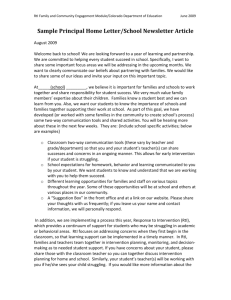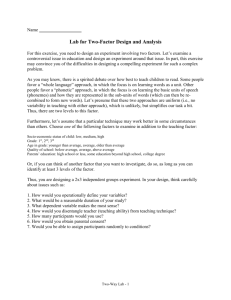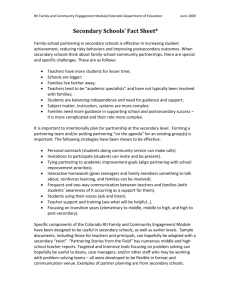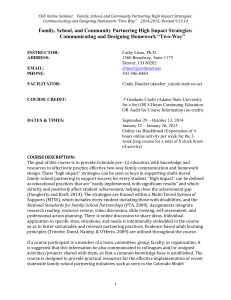Document 15590406
advertisement
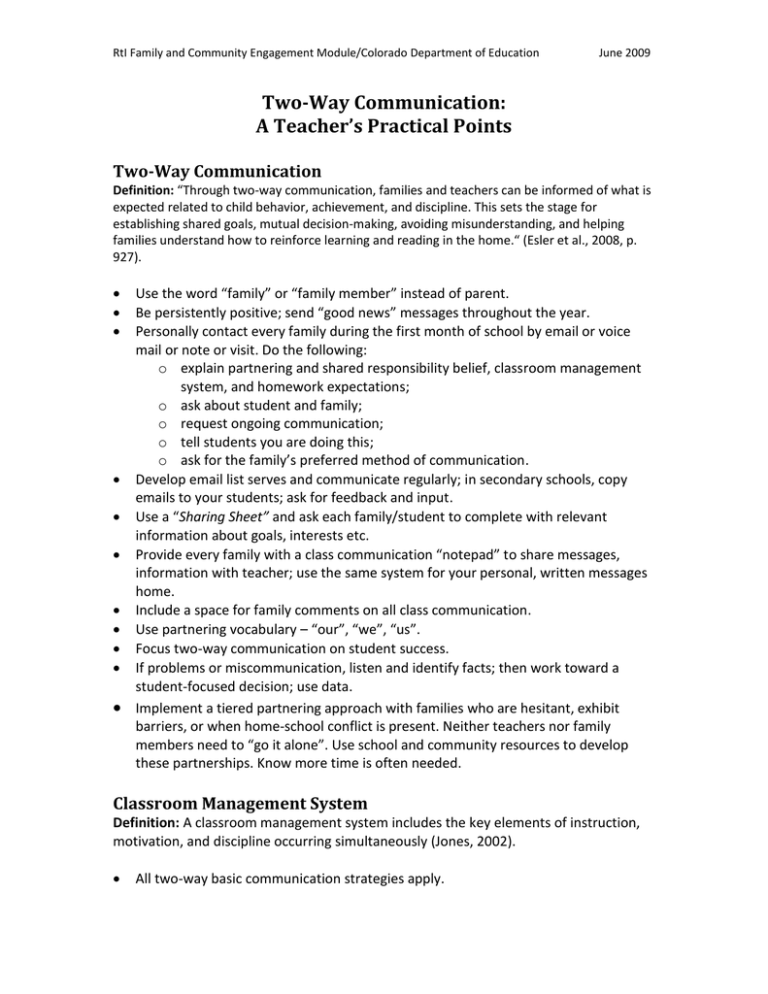
RtI Family and Community Engagement Module/Colorado Department of Education June 2009 Two-Way Communication: A Teacher’s Practical Points Two-Way Communication Definition: “Through two-way communication, families and teachers can be informed of what is expected related to child behavior, achievement, and discipline. This sets the stage for establishing shared goals, mutual decision-making, avoiding misunderstanding, and helping families understand how to reinforce learning and reading in the home.“ (Esler et al., 2008, p. 927). Use the word “family” or “family member” instead of parent. Be persistently positive; send “good news” messages throughout the year. Personally contact every family during the first month of school by email or voice mail or note or visit. Do the following: o explain partnering and shared responsibility belief, classroom management system, and homework expectations; o ask about student and family; o request ongoing communication; o tell students you are doing this; o ask for the family’s preferred method of communication. Develop email list serves and communicate regularly; in secondary schools, copy emails to your students; ask for feedback and input. Use a “Sharing Sheet” and ask each family/student to complete with relevant information about goals, interests etc. Provide every family with a class communication “notepad” to share messages, information with teacher; use the same system for your personal, written messages home. Include a space for family comments on all class communication. Use partnering vocabulary – “our”, “we”, “us”. Focus two-way communication on student success. If problems or miscommunication, listen and identify facts; then work toward a student-focused decision; use data. Implement a tiered partnering approach with families who are hesitant, exhibit barriers, or when home-school conflict is present. Neither teachers nor family members need to “go it alone”. Use school and community resources to develop these partnerships. Know more time is often needed. Classroom Management System Definition: A classroom management system includes the key elements of instruction, motivation, and discipline occurring simultaneously (Jones, 2002). All two-way basic communication strategies apply. RtI Family and Community Engagement Module/Colorado Department of Education June 2009 In your initial communication to each student’s family, briefly share information about your classroom management system and that the student will be sharing more specific details with them. Share rules, positive supports, and operating procedures with families in multiple venues such as on the website, emails, notes home, handbooks. At the beginning of the term, “assign” students to discuss the operating information with family members and request written, email, and/or verbal confirmation/input from family members; follow up if you don’t hear back. If you are worried a student might have challenges in following rules or engaging in learning, work proactively to build a trusting relationship with the family; communicate frequently about positive news before concerns are evidenced, so that there is the expectation that home and school will be involved in solving problems; include your observation of student strengths. If a student is struggling with learning or behavior issues, invite the family to partner in solving the problem with the student. Develop a plan which includes two-way communication and support. Homework Definition: “Tasks assigned to students by school teachers that are meant to be carried out during non-school hours.” (Cooper, 1989, p. 7) All general two-way communication strategies apply. In your initial communication to each student’s family, briefly share information about the class homework expectations for home and school. In your homework description, explain the following: specific philosophy; teacher, student, family roles; time expectations and any individualized procedures; expectation of early home-school communication if problems occur; explanation of shared problem-solving process to resolve concerns. Emphasize the importance of families supporting learning at home, every day. Share homework information with families in multiple venues such as website, emails, notes home, and handbooks. At the beginning of the term, “assign” students to discuss the homework process with family members and request written, email, and/or verbal confirmation/input from family members; follow up if you don’t hear back. Develop “interactive homework” assignments where students and families work together in learning; this can be students teaching families, or shared activities; inform families; do regularly; require family feedback for each assignment; share that you don’t expect perfection; proactively problem-solve for barriers such as illiteracy or language differences. (Constantino, 2008; Epstein et al., 2002) Provide individualized “homework help” for students or families when either might be struggling independently or together – it is all about student success. RtI Family and Community Engagement Module/Colorado Department of Education June 2009 References Constantino, S.M., (2008). 101 ways to create real family engagement. Galax, VA: ENGAGE! Press. Epstein, J.L., Sanders, M.V., Simon, B.S., Salinas, K.C., Jansorn, N.R., & Van Voorhis, F.L. (2002). School, family, and community partnerships: Your handbook for action. Thousands Oaks, CA: Corwin Press. Esler A., Godber Y., & Christenson, S. (2008). Best practices in supporting home-school collaboration. In A. Thomas & J. Grimes (Eds.), Best practices in school psychology V (pp. 917-936). Bethesda, MD: National Association of School Psychologists. Jones. F. (2000). Tools for teaching. Santa Cruz, CA: Fred H. Jones & Associates, Inc. Cooper, H. (1989). Homework. New York: Longman.

